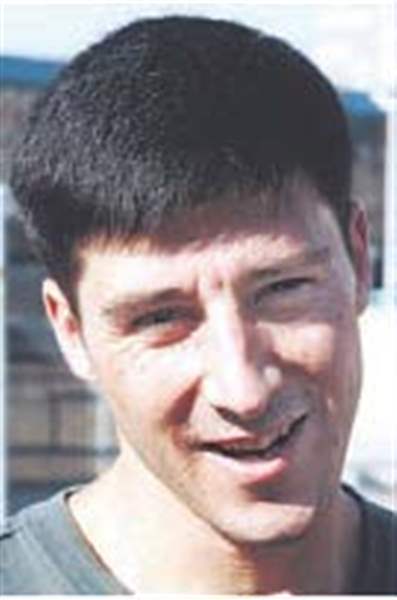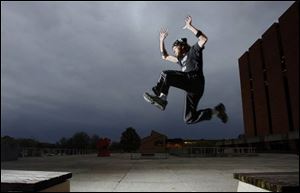
Parkour practitioners run up walls, leap over rails, jump steps just for fun
10/21/2007
Frenchman David Belle, left, is credited with starting parkour.

Mike Schiewer leaps while practicing the French sport parkour at Bowling Green State University.
To an off-duty ninja, nothing is simple. Not even walking down a wheelchair-access ramp.
That s why Mike Schiewer wearing a black sweatband on each arm and a T-shirt identifying his secret vocation finds himself running at a 12-foot wall.
Instead of just turning left around the corner of the ramp like everybody else, his rubber soles grip the concrete as he scrambles up the surrounding wall and hoists himself over the top.
For the 25-year-old South Toledo man this is just practice, but he understands that others might not get it.
There s just something not natural about jumping into a concrete wall, he says.
And yet the idea behind what he s up to has a natural simplicity. It s called parkour, and the basic philosophy behind it is to move through your environment as efficiently and quickly as possible.
These days, that s probably more of a theoretical than practical issue. Other than police or soldiers, not too many people are put in positions where they need to overcome obstacles using only their body.
In everyday life, there really is no need for it, admitted Mr. Schiewer. The only time it would be efficient is if for some reason someone was chasing you.
Still, to practitioners of the sport or art or discipline or philosophy, depending who you ask every object in the urban landscape is a welcome obstacle. Railings are meant to be jumped. (Ditto for stairs.) Hedges are meant to be hurdled. Walls are meant to be scaled.
To the general public, parkour may be best known through its use in film: The opening of the latest James Bond movie, Casino Royale, has a dynamite parkour chase at a construction site.
The practice is relatively new, dating back less than 20 years to France and a man named David Belle. The son of a firefighter, he took exercises that are part of French fire and military training, and developed them to the extreme.
Mr. Belle, 34, was in the U.S. earlier this month at the New Yorker magazine s annual festival, showing off his fluid, graceful moves as he climbed and jumped from 20-foot concrete columns. Local traceurs that s what practitioners of the sport are called will provide a spectacle of their own when they gather with others at Bowling Green State University today for a jam starting at noon at the Bowen-Thompson Student Union.

Top to bottom: Andy Thurman, 15, left, and Robert Aaron Johnson, 16, of the Metro Angels, perform backflips off of a wall in Monroe as they practice parkour.
Mr. Schiewer, who organized the event, discovered parkour two years ago and learned his first lessons, as so many traceurs do, by watching online videos. He s embraced the freedom of the sport and its improvisational nature.
I like the fact that I can find my own path, he says. I don t have to adapt to it. It adapts to me.
The discipline (whose name is a made-up term derived from a French phrase for a kind of obstacle course) and an offshoot called free running have a following in America that is small but dedicated and growing.
Mark Toorock founded the Web site americanparkour.com a couple of years ago as a place for this country s practitioners to meet and collaborate. Now the Washington man has 20,000 people registered and 42,000 unique visitors a month.
It appeals, Mr. Toorock says, to everyone from would-be skateboarders looking for the next cool thing to martial arts aficionados seeking another challenging discipline. And while most practitioners are young and male, the parkour classes he s started also attract businessmen and moms.
Parkour is a training methodology where the physical activity is overcoming obstacles, but the real benefit is what you gain for yourself, Mr. Toorock says. You grow through the experience, through training, pushing yourself, overcoming your fears.
Just as many who study karate don t expect to ever use it in a fight, most people don t try parkour so they can better escape from someone.
In Monroe, a group of traceurs who call themselves Metro Angels meet regularly to practice fundamental parkour moves: precision jumps, vaults, and rolling landings. Mostly high schoolers and recent graduates, they are led by Meldrum MacPetrie, a 34-year-old who works part-time as a martial arts instructor.
It really trains your mind and body, he says. It s a way of life and it takes a lot of steam off.
Watching his group is like being transported back to your youth, when everything could be made into a toy. Members pop from one obstacle to another at a frenetic pace at a local playground like kids hopping around household furniture.
They jump from one picnic table to another. They leap off the top of jungle gyms. One guy in a white sleeveless T-shirt runs up the trunk of a tree before thrusting himself backwards in a flip, landing on his feet.

Frenchman David Belle, left, is credited with starting parkour.
The sweaty gang wanders around town, often single-file, lingering at a park or school or other promising location long enough to try a few moves at Mr. MacPetrie s instruction before moving on. It s hard to find a place with enough obstacles to string together too many moves, so they usually practice one here or there.
Occasionally they are interrupted by someone wondering exactly what they re doing or shooing them away, but local police said they haven t had any complaints from property owners.
Some people call it crazy, and Thomas Amison, 19, says that includes his mom. But he and his younger brother Chris have been part of the Metro Angels for three months now, and he says it keeps them fit and out of trouble.
After I got out of school, I didn t do pretty much anything constructive, he says. This was very interesting. This was how come I got off the couch.
Local traceurs say they ve only come away with bumps and bruises and that fear helps keep them in check. Still, there have been close calls like when one traceur barely makes a jump over a pole in the ground, leading Mr. Amison to exclaim: That kid was about to get neutered!

A parkour chase scene from the recent James Bond movie Casino Royale.
Dr. Jeff Cooper, an emergency medicine physician at St. Vincent Mercy Medical Center, says parkour comes with many of the same risks as skateboarding or skiing. Practitioners need to remember to bring a progressive approach to the discipline, taking things slowly to build up their skill sets, strength, and stability.
It s just like gymnastics, he says. You don t just jump on the rings and start to do flips.
Veteran traceurs stress the importance of not trying anything you re not sure you can do and of practicing jumps first from ground level and moving gradually higher. Jumping from one line to another in a parking lot is good practice, they say.
I always tell everybody, you ve got to take baby steps, Mr. MacPetrie says. You just jump right into it, [and] a lot of people get hurt and that s not cool.
Back at BGSU a treasure trove of obstacles for traceurs Mr. Schiewer likes to practice some moves on an elevated porch outside of Jerome Library with student Nicolas Finn, 18, of Sylvania Township.
He leaps high over a rail, sailing in slow motion through the air and rolling easily onto the grass eight feet below.
A couple of guys walk by, their eyes wide.
I ll bet you could do it, one of them says.
Naaaah, the other responds after giving it some thought.
And they walk away as Mr. Schiewer tightrope walks his way up the stair railing for another go.
Contact Ryan E. Smith at:ryansmith@theblade.comor 419-724-6103.